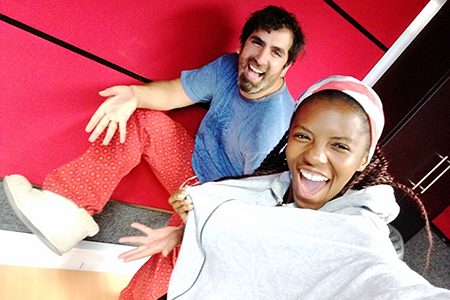12 February 2018
Photo Supplied
 Richard and Fifi from the Kovsie FM Breakfast Show
Richard and Fifi from the Kovsie FM Breakfast Show
Richard Chemaly completed a BCom degree at the University of the Free State (UFS) in 2010 before he enrolled for an LLB, and is currently doing an LLM in legal philosophy. He was also a familiar face on campus as SRC President. After jetting around the world, Richard is back in Bloemfontein. Since becoming a DJ for the Breakfast Show at Kovsie FM, he is now responsible for starting the day for listeners on a good note.
Blending law and entertainment fell into my lap. After locking up my Hillbrow apartment, I travelled for a year, accidentally fell in love and moved back to Bloemfontein. Nobody wanted to hire me. Could have been my unconventional Facebook presence, or appearing on ANN7… I don’t know. I was already in the entertainment field because one of my business partners and I started a beer distribution company, which got us a lot of free beer. We then realised that if we started an entertainment blog, which we did, we’d get free access to cool parties, which we did. It just made sense to venture into entertainment law, which suited my personality.
Radio was never my thing, and I have always regretted that. Music was always my thing, though, so the transition was easy. My co-host, Fifi, is my polar opposite. As a young black female who likes old R&B, trap and alternative pop, she brings everything I can’t as an old, hairy Lebanese punk-rocking dude. The dynamic is incredible.
I’m a big lover of mornings and I try to get in an early morning jog and hunting for geocaches before I aim to make even the grumpiest morning listener smile. With an exceptional knowledge of current affairs, it is easy to get across to our diverse listenership. Quick wit and my co-presenter also help! The Breakfast Show sets the tone for the day, and we get good feedback.
I would still like to take over the Musicon and become a pilot.